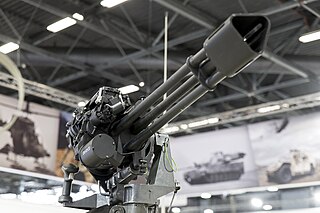
The Gatling gun is a rapid-firing multiple-barrel firearm invented in 1861 by Richard Jordan Gatling. It is an early machine gun and a forerunner of the modern electric motor-driven rotary cannon.

The Heckler & Koch MP5 is a submachine gun developed in the 1960s by German firearms manufacturer Heckler & Koch. It uses a similar modular design to the Heckler & Koch G3, and has over 100 variants and clones, including selective fire, semi-automatic, suppressed, compact, and even marksman variants. The MP5 is one of the most widely used submachine guns in the world, having been adopted by over forty nations and numerous militaries, police forces, intelligence agencies, security organizations, paramilitaries, and non-state actors.

The M2 machine gun or Browning .50 caliber machine gun is a heavy machine gun that was designed near the end of World War I by John Browning. While similar to Browning's M1919 Browning machine gun, which was chambered for the .30-06 cartridge, the M2 uses Browning's larger and more powerful .50 BMG cartridge. The design has had many designations; the official U.S. military designation for the infantry type is Browning Machine Gun, Cal. .50, M2, HB, Flexible. It has been used against infantry, light armored vehicles, watercraft, light fortifications, and low-flying aircraft.

The arms industry, also known as the defence industry, military industry, or the arms trade, is a global industry which manufactures and sells weapons and other military technology to a variety of customers, including the armed forces of states and civilian individuals and organizations. Products of the arms industry include weapons, munitions, weapons platforms, communications systems and other electronics, and related equipment. The arms industry also provides defense-related services, such as logistical and operational support.
The M134 Minigun is an American 7.62×51mm NATO six-barrel rotary machine gun with a high rate of fire. It features a Gatling-style rotating barrel assembly with an external power source, normally an electric motor. The "Mini" in the name is in comparison to larger-caliber designs that use a rotary barrel design, such as General Electric's earlier 20 mm M61 Vulcan, and "gun" for the use of rifle ammunition as opposed to autocannon shells.

The PPSh-41 is a selective-fire, open-bolt, blowback submachine gun that fires the 7.62×25mm Tokarev round. It was designed by Georgy Shpagin of the Soviet Union to be a cheaper and simplified alternative to the PPD-40.

CornerShot is a weapon accessory created by Lt. Col. Amos Golan of the Israeli Defense Forces in cooperation with American investors. It was designed in the early 2000s for use by SWAT teams and special forces in hostile situations usually involving terrorists and hostages. Its purpose is similar to that of the periscope rifle; it allows its operator to both see and attack an armed target without exposing the operator to counterattack.
An arms embargo is a restriction or a set of sanctions that applies either solely to weaponry or also to "dual-use technology." An arms embargo may serve one or more purposes:

The Pantsir missile system is a family of self-propelled, medium-range surface-to-air missile and anti-aircraft artillery systems. Three types of vehicles make up one system: a missile launcher, a radar truck and a command post. Starting with the Pantsir-S1 as the first version, it is produced by KBP Instrument Design Bureau of Tula, Russia, and is the successor to the Tunguska M1.

The GAU-19/A is an electrically driven, three-barrel rotary heavy machine gun that fires the .50 BMG cartridge.

The KS-19 100mm anti-aircraft gun is a Soviet anti-aircraft gun that also features efficient capabilities against ground targets.

The Iranian Armed Forces, officially the Islamic Republic of Iran Armed Forces, are the combined military forces of Iran, comprising the Islamic Republic of Iran Army (Artesh), the Islamic Revolutionary Guard Corps (Sepah) and the Law Enforcement Command (Faraja).
A loitering munition, also known as a suicide drone, kamikaze drone, or exploding drone, is a kind of aerial weapon with a built-in warhead that is typically designed to loiter around a target area until a target is located, then attack the target by crashing into it. Loitering munitions enable faster reaction times against hidden targets that emerge for short periods without placing high-value platforms near the target area and also allow more selective targeting as the attack can be changed mid-flight or aborted.

Akhgar missile is an Iranian drone-launched air-to-ground missile operated by the Islamic Republic of Iran Air Force. This Unmanned aerial vehicle weapon, which is among the newest missiles of Iranian drones, has a range of 30 km, its weight is twenty seven kg and its maximum speed is 600 kilometers per hour.











